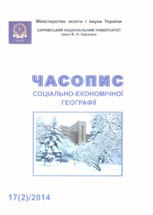USE OF GIS IN URBAN TERRITORY DEVELOPMENT RESEARCH
Ключові слова:
GIS data base, spatial transformations, urban territory, urban territory development management, social infrastructure, instrument, forecast.
Анотація
The paper investigates socio-geographic approach forming of spatial data bases which can be used for regulation of urban territory transformation processes. The authors have displayed the system of factors that determine current spatial transformations in Zaporizhia-city and their impact on function changes on urban areas. The structure of GIS was created as a data base with the aim to display spatial transformations of urban area. The abilities of GIS were identified in the contest of Zaporizhia-city urban territory development management.
Завантаження
##plugins.generic.usageStats.noStats##
Посилання
1. Chang, K.T. (2008). Introduction to Geographical Information Systems. New York: McGraw Hill. p. 184.
2. Geenhuizen M., Nijkamp, P. (1995), Urbanization, Industrial Dynamics and Spatial Development: A Company Life History Approach. In: Urban Agglomerations and Economic Growth. (Publications of the Egon-Sohmen-Foundation), pp. 39-79. Berlin: Springer-Verlag.
3. Krylov, M. (2010): "Regional identity of European Russia”. Moscow, New Chronograph (in Russian).
4. Melnychuk, A. (2008): “Approaches to determine the historical-geographical cross-sections of the socio-geographical complex of Ukraine formation and development”, History of Ukrainian Geography, Kyiv, Textbooks and Manuals, 18: 90-96 (in Ukrainian).
5. Millard and Christensen (2004): “Regional Identity in the Information Society”. BISER Domain Report, N. 4.
6. Rastvorova, M., Melnychuk, A. (2011): “Questionnaires as a method to study regional identity, local patriotism, rootedness and spatial identification of population”. Geographic education and national self-consciousness: current developmental problems. Proceedings of Ukrainian scientific-practical conference of students and young sci-entists, Donetsk: 83-85 (in Ukrainian).
7. Rastvorova M. (2011): “The development and suggestions of the questionnaire to determine the attractiveness of life and rootedness of residents”, Proceedings of International Interdisciplinary Scientific Conference of Young Scientists “Shevchenkivska Vesna”, Kyiv, 9: 200-201 (in Ukrainian).
8. Turovsky R. (1999): “Regional identity in Modern Russia”, Russian Society: Establishment of democratic values?, Moscow, Gandalf (in Russian).
9. Zhekulin, V. (1982): “Historical Geography: the subject and methods”, Leningrad, Nauka (in Russian).
10. Novoe Zaporozhie: hronica razvitia bolshogo goroda. 1921-2006 / N. Kuzmenko, N. Mikhaylov. – Dnepropetrovsk: ART-PRESS, 2006. – 216 c. [Новое Запорожье: хроника развития большого города. 1921-2006 / Н. Кузьменко, Н. Михайлов. – Днепропетровск: АРТ-ПРЕСС, 2006. – 216 с.].
11. Rastvorova M. Misto Zaporizhia: rozvytok miskoyi terutoriyi v dovoyennyj period / M.O. Rastvorova // Shevchenkivska vesna. – 2014. Chastyna 3: Geografia: Zbirnik naukovih prats XII mizhnarodnoi naukovoi mizhdisciplinarnoi konferencii studentiv, aspirantiv I molodih vchenih. – K.: Print-Servis, 2014. Vipusk XII. – 311 s. – S. 209-212. [Растворова М. Місто Запоріжжя: розвиток міської території в довоєнний період / М.О. Растворова // Шевченківська весна – 2014. Частина 3: Географія: Збірник наукових праць XII міжна-родної наукової міждисциплінарної конференції студентів, аспірантів та молодих вчених. – К.: Прінт-Сервіс, 2014. Випуск XII. – 311 с. – С. 209-212.].
12. Socialno-economichnyj i politichnyj passport Shevchenkivskoho rayonu. Ofitsiynyj portal Zaporizkoyi miskoi vlady. [Internet resurs]. – Rezhym dostupu – http://www.meria.zp.ua/test/index.php?id=207 [Соціально-економічний і політичний паспорт Шевченківського району. Офіційний портал Запорізької міської влади. [Інтернет ресурс]. – Режим доступу – http://www.meria.zp.ua/test/index.php?id=207].
2. Geenhuizen M., Nijkamp, P. (1995), Urbanization, Industrial Dynamics and Spatial Development: A Company Life History Approach. In: Urban Agglomerations and Economic Growth. (Publications of the Egon-Sohmen-Foundation), pp. 39-79. Berlin: Springer-Verlag.
3. Krylov, M. (2010): "Regional identity of European Russia”. Moscow, New Chronograph (in Russian).
4. Melnychuk, A. (2008): “Approaches to determine the historical-geographical cross-sections of the socio-geographical complex of Ukraine formation and development”, History of Ukrainian Geography, Kyiv, Textbooks and Manuals, 18: 90-96 (in Ukrainian).
5. Millard and Christensen (2004): “Regional Identity in the Information Society”. BISER Domain Report, N. 4.
6. Rastvorova, M., Melnychuk, A. (2011): “Questionnaires as a method to study regional identity, local patriotism, rootedness and spatial identification of population”. Geographic education and national self-consciousness: current developmental problems. Proceedings of Ukrainian scientific-practical conference of students and young sci-entists, Donetsk: 83-85 (in Ukrainian).
7. Rastvorova M. (2011): “The development and suggestions of the questionnaire to determine the attractiveness of life and rootedness of residents”, Proceedings of International Interdisciplinary Scientific Conference of Young Scientists “Shevchenkivska Vesna”, Kyiv, 9: 200-201 (in Ukrainian).
8. Turovsky R. (1999): “Regional identity in Modern Russia”, Russian Society: Establishment of democratic values?, Moscow, Gandalf (in Russian).
9. Zhekulin, V. (1982): “Historical Geography: the subject and methods”, Leningrad, Nauka (in Russian).
10. Novoe Zaporozhie: hronica razvitia bolshogo goroda. 1921-2006 / N. Kuzmenko, N. Mikhaylov. – Dnepropetrovsk: ART-PRESS, 2006. – 216 c. [Новое Запорожье: хроника развития большого города. 1921-2006 / Н. Кузьменко, Н. Михайлов. – Днепропетровск: АРТ-ПРЕСС, 2006. – 216 с.].
11. Rastvorova M. Misto Zaporizhia: rozvytok miskoyi terutoriyi v dovoyennyj period / M.O. Rastvorova // Shevchenkivska vesna. – 2014. Chastyna 3: Geografia: Zbirnik naukovih prats XII mizhnarodnoi naukovoi mizhdisciplinarnoi konferencii studentiv, aspirantiv I molodih vchenih. – K.: Print-Servis, 2014. Vipusk XII. – 311 s. – S. 209-212. [Растворова М. Місто Запоріжжя: розвиток міської території в довоєнний період / М.О. Растворова // Шевченківська весна – 2014. Частина 3: Географія: Збірник наукових праць XII міжна-родної наукової міждисциплінарної конференції студентів, аспірантів та молодих вчених. – К.: Прінт-Сервіс, 2014. Випуск XII. – 311 с. – С. 209-212.].
12. Socialno-economichnyj i politichnyj passport Shevchenkivskoho rayonu. Ofitsiynyj portal Zaporizkoyi miskoi vlady. [Internet resurs]. – Rezhym dostupu – http://www.meria.zp.ua/test/index.php?id=207 [Соціально-економічний і політичний паспорт Шевченківського району. Офіційний портал Запорізької міської влади. [Інтернет ресурс]. – Режим доступу – http://www.meria.zp.ua/test/index.php?id=207].
Опубліковано
2014-12-03
Цитовано
Як цитувати
Melnichuk, A., & Rastvorova, M. (2014). USE OF GIS IN URBAN TERRITORY DEVELOPMENT RESEARCH. Часопис соціально-економічної географії, 17(2), 167-170. https://doi.org/10.26565/2076-1333-2014-17-27
Розділ
Наукові повідомлення




